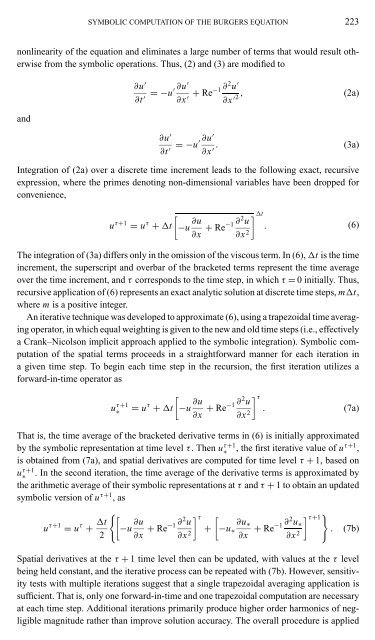A Preliminary Study of the Burgers Equation with Symbolic ...
A Preliminary Study of the Burgers Equation with Symbolic ...
A Preliminary Study of the Burgers Equation with Symbolic ...
You also want an ePaper? Increase the reach of your titles
YUMPU automatically turns print PDFs into web optimized ePapers that Google loves.
SYMBOLIC COMPUTATION OF THE BURGERS EQUATION 223<br />
nonlinearity <strong>of</strong> <strong>the</strong> equation and eliminates a large number <strong>of</strong> terms that would result o<strong>the</strong>rwise<br />
from <strong>the</strong> symbolic operations. Thus, (2) and (3) are modified to<br />
and<br />
∂u ′<br />
=−u′∂u′<br />
∂t ′<br />
∂x ′ +Re−1 ∂2 u ′<br />
, (2a)<br />
∂x ′2<br />
∂u ′<br />
=−u′∂u′<br />
∂t ′ ∂x ′.<br />
(3a)<br />
Integration <strong>of</strong> (2a) over a discrete time increment leads to <strong>the</strong> following exact, recursive<br />
expression, where <strong>the</strong> primes denoting non-dimensional variables have been dropped for<br />
convenience,<br />
uτ+1 = uτ <br />
+ t −u ∂u<br />
∂x + Re−1 ∂2u ∂x 2<br />
t<br />
. (6)<br />
The integration <strong>of</strong> (3a) differs only in <strong>the</strong> omission <strong>of</strong> <strong>the</strong> viscous term. In (6), t is <strong>the</strong> time<br />
increment, <strong>the</strong> superscript and overbar <strong>of</strong> <strong>the</strong> bracketed terms represent <strong>the</strong> time average<br />
over <strong>the</strong> time increment, and τ corresponds to <strong>the</strong> time step, in which τ = 0 initially. Thus,<br />
recursive application <strong>of</strong> (6) represents an exact analytic solution at discrete time steps, mt,<br />
where m is a positive integer.<br />
An iterative technique was developed to approximate (6), using a trapezoidal time averaging<br />
operator, in which equal weighting is given to <strong>the</strong> new and old time steps (i.e., effectively<br />
a Crank–Nicolson implicit approach applied to <strong>the</strong> symbolic integration). <strong>Symbolic</strong> computation<br />
<strong>of</strong> <strong>the</strong> spatial terms proceeds in a straightforward manner for each iteration in<br />
a given time step. To begin each time step in <strong>the</strong> recursion, <strong>the</strong> first iteration utilizes a<br />
forward-in-time operator as<br />
u τ+1<br />
∗<br />
= uτ <br />
+ t −u ∂u<br />
∂x + Re−1 ∂2u ∂x 2<br />
τ<br />
. (7a)<br />
That is, <strong>the</strong> time average <strong>of</strong> <strong>the</strong> bracketed derivative terms in (6) is initially approximated<br />
by <strong>the</strong> symbolic representation at time level τ. Then uτ+1 ∗ , <strong>the</strong> first iterative value <strong>of</strong> uτ+1 ,<br />
is obtained from (7a), and spatial derivatives are computed for time level τ + 1, based on<br />
uτ+1 ∗ . In <strong>the</strong> second iteration, <strong>the</strong> time average <strong>of</strong> <strong>the</strong> derivative terms is approximated by<br />
<strong>the</strong> arithmetic average <strong>of</strong> <strong>the</strong>ir symbolic representations at τ and τ + 1 to obtain an updated<br />
symbolic version <strong>of</strong> uτ+1 ,as<br />
u τ+1 =u τ + t<br />
−u<br />
2<br />
∂u<br />
∂x +Re−1 ∂2u ∂x 2<br />
τ <br />
∂u∗<br />
+ −u∗<br />
∂x + Re−1 ∂2u∗ ∂x 2<br />
τ+1 <br />
. (7b)<br />
Spatial derivatives at <strong>the</strong> τ + 1 time level <strong>the</strong>n can be updated, <strong>with</strong> values at <strong>the</strong> τ level<br />
being held constant, and <strong>the</strong> iterative process can be repeated <strong>with</strong> (7b). However, sensitivity<br />
tests <strong>with</strong> multiple iterations suggest that a single trapezoidal averaging application is<br />
sufficient. That is, only one forward-in-time and one trapezoidal computation are necessary<br />
at each time step. Additional iterations primarily produce higher order harmonics <strong>of</strong> negligible<br />
magnitude ra<strong>the</strong>r than improve solution accuracy. The overall procedure is applied














